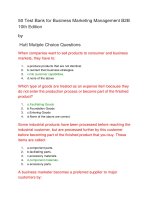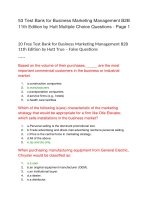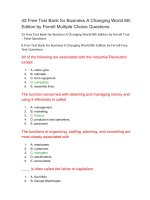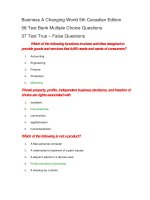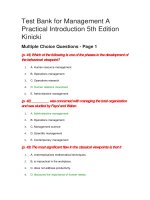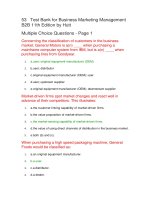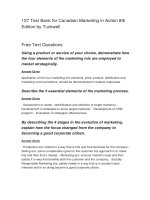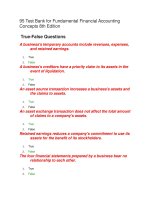Test bank for business a changing world 8th edition
Bạn đang xem bản rút gọn của tài liệu. Xem và tải ngay bản đầy đủ của tài liệu tại đây (153.39 KB, 23 trang )
Test Bank for Business A Changing World 8th Edition
(p. 13) ____ relates to the number of goods and services that consumers are
willing to buy at different prices at a specific time.
1. A. Supply
2. B. Demand
3. C. Elasticity
4. D. Equilibrium
5. E. Economics
(p. 13) The _______ is the price at which the number of products that
businesses are willing to supply equals the number of products consumers
are willing to purchase at a point in time.
1. A. supply price
2. B. equilibrium price
3. C. demand price
4. D. demand curve
5. E. exact price
(p. 13) When Target has a sale on bed linens,
1. A. consumers will not demand more than normal.
2. B. the store will not supply more linens than it normally does.
3. C. consumers will demand more linens.
4. D. the manufacturer will halt production.
5. E. consumers will demand less linens than normal.
(p. 13) When Apple introduced the iPad the price of and demand for netbooks
and notebooks were high. As a result,
1. A. other suppliers introduced competing products to take advantage of the
demand.
2. B. consumers stopped buying netpads.
3. C. manufacturers stopped producing netpads.
4. D. competition was not allowed to enter the market.
5. E. the equilibrium price met supply.
(p. 13) Using the supply and demand curves shown in the graph that follows,
what is the equilibrium price for soft drinks?
1. A. 35 cents
2. B. 45 cents
3. C. 50 cents
4. D. 55 cents
5. E. 75 cents
(p. 14) When businesses can promote different features of their products and
consumers are willing to pay more for products containing the features they
desire, the competitive environment is probably
1. A. pure competition.
2. B. monopolistic competition.
3. C. oligopoly.
4. D. monopoly.
5. E. pure capitalism.
(p. 14) Agricultural commodities are usually sold under which competitive
environment?
1. A. Monopoly
2. B. Monopolistic competition
3. C. Pure competition
4. D. Oligopoly
5. E. Modified competition
(p. 14) ___________ exists when there are many small businesses selling one
standardized product.
1. A. Monopolistic competition
2. B. Oligopoly
3. C. Pure competition
4. D. Monopoly
5. E. Market structure
(p. 9) _________________ is the study of how resources are distributed for the
production of goods and services within a social system.
1. A. Financial resources
2. B. Human resources
3. C. Economic system
4. D. Communism
5. E. Economics
(p. 16) ________________ can be harmful if individuals' incomes do not increase at
the same pace as rising prices because it reduces their buying power.
1. A. Deflation
2. B. Stagflation
3. C. Inflation
4. D. Economic expansion
5. E. Economic contraction
(p. 16-17) Economic expansion occurs when
1. A. fewer goods and services are produced than consumers demand.
2. B. an economy is growing and people are spending more money.
3. C. a nation`s standard of living drops quickly.
4. D. employment levels decline over time.
5. E. prices begin to rise and incomes begin to fall.
(p. 16) A continuing rise in prices over a period of time refers to
1. A. inflation.
2. B. economic expansion.
3. C. a recession.
4. D. economic contraction.
5. E. stagflation.
(p. 16) Economic contraction occurs when
1. A. spending increases.
2. B. spending declines.
3. C. jobs increase.
4. D. inflation decreases.
(p. 17) Countries measure the state of their economies to
1. A. determine whether they are expanding or contracting.
2. B. regulate wages and employment.
3. C. let other nations know the state of their economic health.
4. D. avoid taking corrective action.
5. E. control government spending.
(p. 16) Increased unemployment can reduce consumer demand for goods and
services, leading to
1. A. economic contraction.
2. B. inflation.
3. C. deflation.
4. D. a budget deficit.
(p. 17) A budget surplus, when a nation spends less than it takes in from
taxes, is the opposite of a(n)
1. A. stagnant income.
2. B. budget deficit.
3. C. economic expansion.
4. D. balance of trade.
5. E. economic contraction.
(p. 19) The early economy of the United States was marked by colonists who
operated a society based primarily on
1. A. manufacturing.
2. B. technology.
3. C. sweat shops.
4. D. information.
5. E. agriculture.
(p. 20) All of the following are associated with the Industrial Revolution
except
1. A. cotton gins.
2. B. railroads.
3. C. farm equipment.
4. D. computers.
5. E. assembly lines.
(p. 21) In the history of the American economy, the period or stage following
the Industrial Revolution was known for its emphasis on
1. A. service.
2. B. technology.
3. C. manufacturing.
4. D. agriculture.
5. E. information.
(p. 21) The entrepreneur has been primarily associated with willingness
to
1. A. stay conventional.
2. B. follow others.
3. C. take risks.
4. D. be repetitive.
5. E. be conservative.
(p. 21) The United States is now considered a service-oriented economy, with
the service industry accounting for an estimated _____ percent of the total
U.S. economy.
1. A. 40
2. B. 50
3. C. 70
4. D. 80
(p. 21) Trends have gradually changed the U.S. to a(n) _____ economy focused
on making life easier for busy consumers.
1. A. manufacturing
2. B. service
3. C. agriculture
4. D. technology
5. E. marketing
(p. 21) All of the following are associated with the manufacturing economy
except
1. A. buying on credit.
2. B. marketing.
3. C. advertising.
4. D. cable television.
5. E. marketing research.
(p. 24) What is the primary lesson to be learned from the economic scandals
of the early 21st century?
1. A. Businesses` reputations depend on more than profits
2. B. Ethical conduct and corporate social responsibility are very important
3. C. Most businesses can focus on their bottoms lines, to the exclusion of other
factors
4. D. A and B, but not C
5. E. B and C, but not A
(p. 29) Shelly's business was successful for all of the following reasons
except
1. A. quality product.
2. B. appropriate incentives for employees.
3. C. productive employees.
4. D. employees who enjoyed being part of a new business.
5. E. she had no competitors.
(p. 29) After demand began to accelerate beyond supply, Mrs. Acres
Homemade Pies was faced with a series of options. Which of the following is
NOT one of those options?
1. A. Maintain current production levels and raise prices
2. B. Expand the facility and staff while maintain price
3. C. Contract the production of pies to a national restaurant chain
4. D. Maintain current levels of product and reduce the price
5. E. Increase production and maintain the price
(p. 4) ____ is the primary goal of business.
1. A. Growth
2. B. Profit
3. C. IPO
4. D. Marketing
5. E. Strategy
(p. 4) Businesses differ from nonprofit organizations in that a business's focus
is on
1. A. price.
2. B. goods.
3. C. profit.
4. D. organization.
5. E. plans.
(p. 4) ____ have both tangible and intangible characteristics.
1. A. Products
2. B. Services
3. C. Businesses
4. D. Stakeholders
5. E. Organizations
(p. 4) Profit is the reward for business in exchange for the ____ taken in
providing products.
1. A. expenses
2. B. time
3. C. energy
4. D. risks
5. E. markets
(p. 4) When purchasing, a consumer is actually buying a product's anticipated
benefits and
1. A. satisfaction.
2. B. price.
3. C. costs.
4. D. productivity.
5. E. form.
(p. 5) If a business is to be successful in the long run, it must produce quality
products, operate efficiently, and be
1. A. fun.
2. B. socially responsible.
3. C. hard-working.
4. D. egalitarian.
5. E. transparent.
(p. 4-5) Which of the following is not a product?
1. A. A Dell personal computer
2. B. A veterinarian`s treatment of a pet`s injuries
3. C. A lawyer`s advice in a divorce case
4. D. Business profit
5. E. A checkup by a doctor
(p. 4) The goal of business is to earn
1. A. respect.
2. B. resources.
3. C. a profit.
4. D. responsibility.
5. E. independence.
(p. 5) Customers, employees and investors are examples of:
1. A. constituents.
2. B. stockholders.
3. C. stakeholders.
4. D. entities.
5. E. organizations.
(p. 7) The functions of organizing, staffing, planning, and controlling are most
closely associated with
1. A. employees.
2. B. customers.
3. C. managers.
4. D. stockholders.
5. E. accountants.
(p. 7) Which of the following functions involves activities designed to provide
goods and services that fulfill needs and desires of consumers?
1. A. Accounting
2. B. Engineering
3. C. Finance
4. D. Production
5. E. Marketing
(p. 7) Advertising, personal selling, coupons, and sweepstakes are forms of
_____.
1. A. publicity
2. B. promotion
3. C. marketing research
4. D. management activities
5. E. the marketing mix
(p. 8) When a business fails or does not make a profit, _______ have the most
to lose.
1. A. customers
2. B. workers
3. C. managers
4. D. owners
5. E. consumers
(p. 8) The function concerned with obtaining and managing money and using
it effectively is called
1. A. management.
2. B. marketing.
3. C. finance.
4. D. production and operations.
5. E. personnel.
(p. 6) The group of people to whom the management activity most applies
is
1. A. consumers.
2. B. owners.
3. C. bankers.
4. D. government regulators.
5. E. employees.
(p. 8) ____ have the most to lose if the business fails to make a profit.
1. A. Employees
2. B. Owners
3. C. Banks
4. D. Customers
5. E. Accountants
(p. 9) ____ resources are also known as labor.
1. A. Economic
2. B. Human
3. C. Productive
4. D. Financial
5. E. Natural
(p. 9) Financial resources are also known as _______________.
1. A. capital
2. B. labor
3. C. barter
4. D. economics
5. E. exchange
(p. 9) All the following are factors of production used to make goods and
services except
1. A. natural resources.
2. B. human resources.
3. C. customers.
4. D. capital.
5. E. financial resources.
(p. 9) Factors of production are
1. A. resources used to produce goods and services.
2. B. fixed resources.
3. C. taxes.
4. D. seldom in demand.
5. E. free.
(p. 11) In a capitalist system, individuals own and operate ____
businesses.
1. A. no
2. B. few
3. C. about half
4. D. many
5. E. the majority of
(p. 10) In a socialist system, citizens are dependent on _________ for many
goods and services.
1. A. the government
2. B. the people
3. C. businesses
4. D. supply and demand
5. E. suppliers
(p. 11) ____ is often called the father of capitalism.
1. A. Karl Marx
2. B. George Washington
3. C. Benjamin Franklin
4. D. Alan Greenspan
5. E. Adam Smith
(p. 11) Equal distribution of income and social services is also referred to
as:
1. A. communism.
2. B. egalitarianism.
3. C. capitalism.
4. D. equality.
5. E. democracy.
(p. 10-11) In a socialist economic system, many people work in ___ jobs.
1. A. self-employed
2. B. government
3. C. high-paying
4. D. poverty-wage
5. E. part-time
(p. 11) The American economic system is best described as _______ because
the government regulates business to preserve competition and protect
consumers and employees.
1. A. socialism
2. B. laissez-faire capitalism
3. C. modified capitalism
4. D. communism
5. E. business ownership
(p. 4) Products have tangible attributes only.
1. True
2. False
(p. 4) The primary goal of business activities is profit.
1. True
2. False
(p. 4) Nonprofit organizations such as Habitat for Humanity do not engage in
management, marketing, or finance activities.
1. True
2. False
(p. 4) Profit is what it costs to make and sell a product.
1. True
2. False
(p. 4) Businesses have the right to keep and use their profits as they choose,
without limitations.
1. True
2. False
(p. 8) Finance refers to all activities concerned with obtaining money and
using it effectively.
1. True
2. False
(p. 7-8) Owners have little responsibility to provide funds for the operation of
the business.
1. True
2. False
(p. 6) Managers coordinate resources to achieve the firm's goals.
1. True
2. False
(p. 6) The focus of all marketing activities is customer satisfaction.
1. True
2. False
(p. 6) Owners always manage their businesses.
1. True
2. False
(p. 8) A central issue of economics is how to fulfill an unlimited demand for
goods and services in a world with limited resources.
1. True
2. False
(p. 10) Capitalism is an economic system in which the government owns and
operates basic industries while individuals own most other businesses.
1. True
2. False
(p. 11) Most socialist nations are democratic.
1. True
2. False
(p. 11) In a free-market system, the government regulates business.
1. True
2. False
(p. 11) Free-market capitalism and laissez-faire capitalism are essentially the
same thing.
1. True
2. False
(p. 13) Demand is the quantity of goods and services that consumers are
willing to buy at different prices at a specific time.
1. True
2. False
(p. 13) The equilibrium price is represented by the point where a product's
supply and demand curves intersect.
1. True
2. False
(p. 14) Monopolistic competition exists when there is only one producer of a
product in a given market.
1. True
2. False
(p. 14) An oligopoly exists when there are many small businesses selling one
standardized product.
1. True
2. False
(p. 13-14) A product's equilibrium price is constantly changing in response to
changes in economic conditions, availability of resources, and degree of
competition.
1. True
2. False
(p. 15) Economic expansion occurs when an economy is growing and people
are spending more money.
1. True
2. False
(p. 16) The standard of living rises because people have less money to
spend.
1. True
2. False
(p. 16) A severe recession may turn into a depression.
1. True
2. False
(p. 17) Gross domestic product is the sum of all goods and services produced
in a country during a year.
1. True
2. False
(p. 17) When a nation takes more from taxes than it spends, it has a budget
deficit.
1. True
2. False
(p. 21) The Industrial Revolution brought increasing prosperity and propelled
the United States into a manufacturing economy.
1. True
2. False
(p. 21) After World War II, the United States became an agricultural
economy.
1. True
2. False
(p. 21) Advertising first made consumers aware of differences in products and
prices in the marketing economy.
1. True
2. False
(p. 21) Entrepreneurs risk their wealth, time, and effort to develop for profit
an innovative product or way of doing something.
1. True
2. False
(p. 21) Thomas Edison was an American entrepreneur.
1. True
2. False
